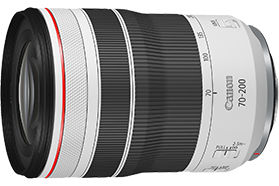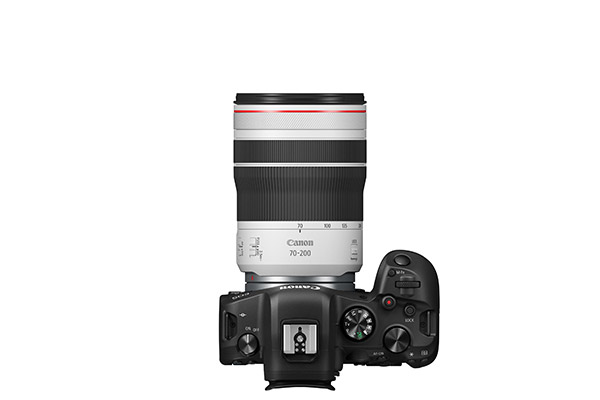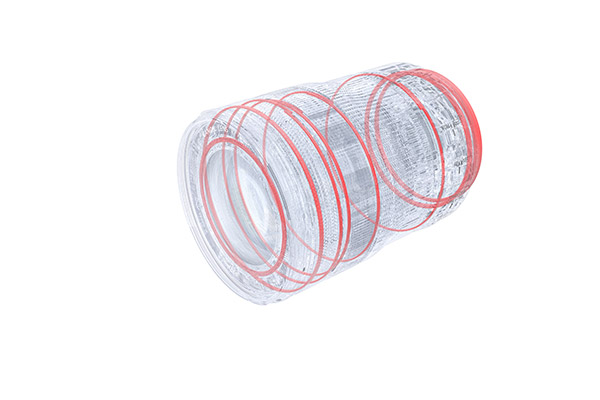Explore null | Canon Latin America

RF 70-200mm f/4L IS USM
- RF 70-200mm f/4L IS USM
- Lens Cap E-77II
- Lens Hood ET-83G(WIII)
- Lens Pouch LP1319
-
OVERVIEW
-
SPECIFICATIONS
-
ACCESSORIES
-
RESOURCES
-
SUPPORT
-
MISCELLANEOUS
The RF 70-200mm f/4L IS USM is a telephoto zoom lens delivering impressive image quality along with superb mobility as our shortest and lightest 70-200mm f/4 lens to date. Designed for the EOS R System, this lens takes advantage of the large diameter mount and short back focus distance of the RF mount to maintain high image quality while being more compact and portable so you’ll be even more inclined to take it with you on your travels. Results are stunning thanks to 4 UD lenses which help correct chromatic aberration and keep colors vivid, reduced ghosting provided by Air-Sphere Coating (ASC), and Optical Image Stabilization* plus coordinated Optical Image Stabilizer and In-Body Image Stabilizer** for amazingly clear, crisp images at slow shutter speeds and smooth video footage. There’s also dual Nano USMs contributing to a short minimum focusing distance and high-speed autofocus for still shooting and near-silent, smooth autofocus during movie shooting. These features and more, combined with the confidence to shoot in almost any condition with dust- and weather resistant seals and fluorine coating, make the RF 70-200mm f/4L IS USM lens a solid performer for any situation.
Convenience is a major consideration when shooting, and the RF 70-200mm f/4L IS USM lens is our most compact and lightest 70-200mm f/4 lens, making it even more appealing to use for your photo and video opportunities. As a more portable 70-200mm option than our EF version, this new RF lens is easier to fit into a messenger bag as well as a camera backpack vertically so it's always on-hand and ready to go.

The EF 70-200mm f/4 lenses provided impressive picture quality and that superb reputation has carried over and has been improved with this RF version. With L series optics and a 9 blade circular aperture for creative bokeh, this is an excellent telephoto complement to the RF 24-105mm f/4L IS USM and will provide you with impressive results, even when shooting in low light situations.

Because RF lenses are designed specifically for the RF Mount found on EOS R series cameras, the lens and camera combine to share shooting data, helping to dramatically reduce the effect of camera shake that can occur when using handheld. This applies when capturing both stills and video with up to 5 stops of stabilization* for accurate and clear content.

When combined with an EOS R series camera equipped with In-Body Image Stabilizer, the lens' Optical Image Stabilizer teams up with the In-Body Image Stabilizer to provide coordinated IS up to 7.5 stops, further helping to alleviate shaking for photos and video, and adjusting the ratio from optical to in-body stabilization automatically throughout the zoom range so you have the best of both worlds.

Like some of its predecessors such as the RF 70-200mm f/2.8L IS USM and RF 100-500mm f/4.5-7.1L IS USM lenses, the RF 70-200mm f/4L IS USM is equipped with dual independent Nano USMs to help achieve high-speed and focus accuracy at any focal length or throughout its travel, and its focusing range. This helps you quickly focus and keep up with fast-moving subjects and also provides smooth and silent autofocus while shooting movies, so there is relatively no disturbance for you, the subject or in what you see visually and hear audibly during shooting and playback.
While the EF 70-200mm f/4L IS II USM counterpart lets you shoot at a minimum focusing distance of approx. 3.3 ft., the dual independent Nano USMs found in the RF 70-200mm f/4L IS USM lets you get even closer, up to 1.97 ft. from the subject at full zoom range and at a maximum magnification of 0.28x (at 200mm), so you can get highly detailed, highly impressive images even at close range with a telephoto zoom lens.

Standard on all RF lenses, the control ring on the lens barrel enables you to adjust numerous settings including shutter speed, aperture, exposure compensation and more. Located towards the front of the lens and effectively adding a third dial to the EOS R and EOS RP, and a fourth dial for EOS R5 and EOS R6 cameras, the control ring has a tactile, easily distinguished surface and features a clicking mechanism that provides tangible feedback for confident use while looking through the viewfinder. For photographers and moviemakers who would prefer a silent control ring, the clicking mechanism can be removed by a Canon service provider for a fee.

Designed to quickly process data, the 12-pin communication system inherent in all RF lenses helps accelerates AF, Image Stabilization, the Digital Lens Optimizer and more, helping to simplify complex operations and provide a quick and reliable user experience.

Dust - and Weather-resistant
Feel confident shooting in almost any weather condition, from rain to snow, thanks to dust- and weather-resistant construction in the lens mount, switch panel, lens barrel extension and all rings. Sealing is applied to lens joining sections and switch panels to help prevent water and dust from entering into the lens.

Fluorine Coating
The RF 70-200mm f/4L IS USM lens features fluorine coatings on the front and rearmost surfaces to help prevent water and oil from sticking to the lens, making it easy to clean off smudges and fingerprints.
Clear, high-quality images are produced with the help of four low refractive and ultra-low dispersion lenses, providing significant chromatic aberration correction through the entire zoom range. In addition, the RF 70-200mm f/4L IS USM lens features our Air Sphere Coating (ASC), which helps to reduce the occurrence of lens flare and ghosting. This helps provide clean results with minimal distractions and aberrations.

* Based on CIPA (Camera & Imaging Products Association) standards. Testing performed at a focal length of 200mm using the EOS R camera.
** Based on CIPA (Camera & Imaging Products Association) standards. Testing performed at a focal length of 200mm using the EOS R5 camera.
*** At 200mm.
| Focal Length Maximum Aperture | 70-200mm, F4-32 |
| Lens Construction | 16 Elements In 11 Groups |
| Diagonal Angle Of View | 34°00′ – 12°00′ |
| Closest Focusing Distance | 1.97 Ft. /0.6m (Throughout Zoom Range) |
| Aperture Control | 9 |
| Filter Size | Ø77mm |
| Max Diameter X Length Weight | Approx. 3.29 In X 4.69 In. / 83.5mm X 119.0mm Approx. 1.5 Lbs. / 695g |
* Based on CIPA (Camera & Imaging Products Association) standards. Testing performed at a focal length of 200mm using the EOS R camera.
** Based on CIPA (Camera & Imaging Products Association) standards. Testing performed at a focal length of 200mm using the EOS R5 camera.
*** At 200mm.

Lens Case LZ1319
Lens pouch cases are compact, yet keep your lenses looking like new.
)
Lens Hood ET-83G (WIII)
Helps to block sunlight or other light sources to prevent glare and lens flare, as well as help protect the lens itself from scratches and the elements.

Lens Dust Cap RF
Helps protect the front glass from dust and scratches.

Lens Cap E-C77 II
Helps protect the front glass from dust and scratches.
- Windows Server 2025
- macOS 15
- macOS 14
- macOS 13
- Windows 11
- macOS 12
- Windows Server 2022
- macOS 11
- Linux MIPS
- Linux ARM
- macOS 11.0
- macOS 10.15
- macOS v10.13
- macOS v10.14
- Windows Server 2019 (x64)
- macOS v10.14
- macOS v10.13
- Windows Server 2016 (x64)
- macOS v10.12
- Linux 64bit
- Linux 32bit
- OS X v10.11
- Windows 10
- Windows 10 (x64)
- OS X v10.10
- Windows Server 2012 R2 (x64)
- OS X v10.9
- Windows 8.1 (x64)
- Windows 8.1
- Windows Server 2012 (x64)
- Windows 8
- Windows 8 (x64)
- Windows 7
- Windows 7 (x64)
- Windows Vista
- Windows Vista (x64)
- Windows XP
- Windows XP (x64)
- Windows Server 2008
- Windows Server 2008 (x64)
- Windows Server 2008 R2 (x64)
- Windows Server 2003
- Windows Server 2003 (x64)
- Windows Server 2003 R2
- Windows Server 2003 R2 (x64)
- Windows 2000
- Windows NT
- Windows 3.1
- Windows Me
- Windows 98
- Windows 95
- Mac OS X v10.8
- Mac OS X v10.7
- Mac OS X v10.6
- Mac OS X v10.5
- Mac OS X v10.4
- Mac OS X v10.3
- Mac OS X v10.2
- Mac OS X v10.1
- Mac OS X
- Mac OS 9
- Mac OS 8
- Linux (x64)
- Linux (x32)
- Linux
- Not Applicable
Locating and Installing Your Download Cómo Localizar e Instalar su Descarga Localizando e Instalando seu Download
How to identify your OS version
To help determine which Windows operating system is running on your computer, please view the below steps:
Windows 11
Click on the Windows button (located left to the Search at the bottom).
Click on the Settings button to navigate to the system settings.
Scroll to the bottom of the page and click on the About button.
You will be able to find your Windows operating system under the Windows Specifications section.
Windows® 10
Click Start or click the Windows button (usually found in the lower-left corner of your screen).
Click Settings.
Click About (which is usually located within the lower left of the screen). The next screen should display the Windows version.
Windows 8 or Windows 8.1
Option1: Swipe in from the upper-right corner of the screen while viewing the desktop in order to open the menu, then select Settings.
Select PC Info. Under Windows edition, the Windows version is shown.
Option 2: From the Start Screen
While on the Start screen, type computer.
Right-click on the computer icon. If using touch, press and hold on the computer icon.
Click or tap Properties. Under Windows edition, the Windows version is shown.
Windows 7
Click Start or click the Windows button (usually found in the lower-left corner of your screen).
Right-click Computer and select Properties from the menu. The resulting screen should now display the Windows version.
Linux
To check the version of your Linux operating system (OS), you can use the following commands in your terminal:
1. uname -r: Displays your Linux kernel version.
2. cat /etc/os-release: Displays your distribution name and version.
3. lsb_release -a: Displays specific details about your Linux distribution and version.
4. You can also use the hostnamectl command to display the Linux kernel version. However, this command is only available on Linux distributions that use systemd by default.
To help determine which Mac operating system is running on your computer, select the Apple menu in the upper-left corner of your screen and choose About This Mac.
Upon selecting, you should see the macOS name followed by the version number.
Canon U.S.A Inc. All Rights Reserved. Reproduction in whole or part without permission is prohibited.